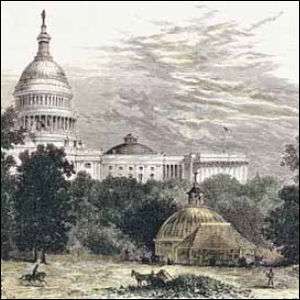United States Botanic Garden
| United States Botanic Gardens | |
|---|---|
|
Engraving from Picturesque America: Or the Land We Live In, Volume II, 1874 | |
 Location within Washington, D.C. | |
| Type | Botanical garden |
| Location | 100 Maryland Ave., SW, Washington, DC 20001, United States |
| Coordinates | 38°53′17″N 77°00′47″W / 38.888°N 77.013°WCoordinates: 38°53′17″N 77°00′47″W / 38.888°N 77.013°W |
| Created | 1820 (formally established in 1850) |
| Administered by | Holly H. Shimizu |
| Visitors | 750,000 per year[1] |
| Status | Open all year including holidays, free admission to all gardens - Conservatory is open 10am to 5pm |
| Website | usbg.gov |
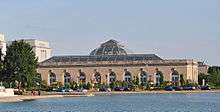
The United States Botanic Garden (USBG) is a botanic garden on the grounds of the United States Capitol in Washington, D.C., near Garfield Circle. The Botanic Garden is supervised by the Congress through the Architect of the Capitol, who is responsible for maintaining the grounds of the United States Capitol. The USBG is open every day of the year, including federal holidays. It is the oldest continually operating botanic garden in the United States.
History
The Columbian Institute for the Promotion of Arts and Sciences in Washington, D.C., first suggested the creation of the Botanic Garden in 1816.[2][3] The idea of establishing a botanic garden in Washington, D.C., was also supported by the Washington Botanical Society, organized in 1817, many of whose members were also members of the Columbian Institute, however this society disbanded in 1826.[4]
In 1820, President James Monroe set aside 5 acres (20,000 m2) for a "national greenhouse." Dr. Edward Cutbush, founder and first president of the Columbian Institute, was one of the earliest advocates for a plant repository and saw the necessity for a botanical garden "where various seeds and plants could be cultivated, and, as they multiplied, distributed to other parts of the Union."[5]
The tract, which was swamp land,[6] was located next to the Smithsonian Museum and a mere eighty feet from the steps of the Capitol.[5] The land was situated between First and Third streets and Pennsylvania and Maryland avenues[7] on the west side of the Capitol building.[8] It was originally owned by David Burnes, the Scots farmer who owned much of the site of the city of Washington. He had been warned in 1796 that if he chose to plant crops "on the avenue and the Mall", it was at his own risk as something might be done "almost any time" to make a thoroughfare.[9]
It is probable that Thomas Jefferson was the first influential person who took an interest in cleaning up the brush that covered the land. By 1810, some rows of Lombardy poplars had been planted, however, the avenue itself "was too much of a morass" to be traversed on horseback.[9]
Botanic Garden of the Columbian Institute
One of the greatest accomplishments of the institution was the creation of a botanic garden in 1821. "By the end of 1823 the swampy tract of land granted by Congress had been drained and leveled, an elliptical pond with an island at its center constructed, and four graveled walks laid out. Trees and shrubs were planted, and the garden was maintained as well as scanty funds would permit until the institute expired in 1837, one year before the termination of its charter."[4]
On May 26, 1824, the grounds were extended and in 1825, they were enclosed. "There seems to be no record of what improvements or plantings were made by the Columbian Institute. The institute had expended $1,500 on the grounds for walks and plantings and had asked Congress to be reimbursed, but this request was not granted."[7]
Although the membership roster of the Columbian Institution included many distinguished citizens and several presidents, they were unable to raise money for the greenhouse and lecture hall.[10] Meetings were held in a variety of temporary offices, including a committee room in the capitol building that Congress granted use of on December 20, 1828.[11]
Despite all the hardships, the Institute quickly launched an enthusiastic effort to collect plants and seeds.[10] In 1826, a committee was appointed to meet with heads of government departments to help solicit "all subjects of natural history that may be deemed interesting" from foreign representatives. The following year, Secretary of the Treasury, Richard Rush was also involved in the solicitation by circulating a letter to foreign dignitaries."[10] In the letter he stated that President John Quincy Adams was "desirous of causing to be introduced into the United States all such trees and plants from other countries not heretofore known in the United States, as may give promise, under proper cultivation, of flourishing and becoming useful...."[10]
The publicity was extremely successful. Plants and seeds made their way to the Institute from as far away as China and Brazil. Some came from areas nearby, such as Montgomery County in Maryland. In 1824, a List of Plants in the Botanic Garden of the Columbian Institute was prepared by William Elliot.[10] The pamphlet mentioned more than 458 plants growing at that time.[7]
Sixteen years passed and by 1836, no further improvements had been made on the property. "The tract was a stagnant and malarial swamp and Congress was prevailed upon to make an appropriation of $5,000 for improvements."[12] The funds were used to drain the site and erect a fountain.[9]
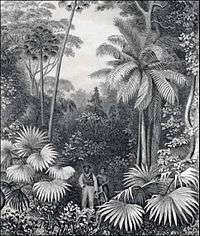
Financial woes continued to plague the Institute, and there was "never enough money from contributions for proper maintenance of the garden and plant collections."[10] The facility ceased to operate in 1837 when the society stopped holding meetings. However it was re-instituted in 1842 when the Wilkes expedition of the South Seas brought back a collection of plants.[13]
Wilkes exploring and surveying expedition
In 1838, Lt. Charles Wilkes set out on the United States Exploring Expedition commissioned by Congress[13] to circumnavigate the globe and explore the Pacific Ocean.[10] Between the years 1838–1842, the expedition, consisting of six government ships, traveled 87,000 miles[5] and collected a large assortment of horticultural and botanical specimens. These formed the nucleus of the present garden.[13] The expedition also confirmed that Antarctica was a continent.[5]
The staff included a botanist, W. D. Breckenridge who brought back a large collection of specimens, including seeds and cuttings.[12]
Because the garden was situated in a swamp, early attempts at cultivation were not successful, however, during 1842; a revival was made after the Wilkes Expedition brought many rare plants to Washington from the Fiji, Sandwich and Society Islands, New Zealand and South America.
During this trip, Wilkes collected live and dried specimens of plants and was one of the first to use wardian cases to maintain live plants on long voyages. Members of the expedition returned with a massive collection of plants previously unknown in the United States.
The dried specimens comprised the core of what is now the National Herbarium, an herbarium curated by the Smithsonian Institution's National Museum of Natural History.
The live Wilkes specimens and seeds "were transferred successively to frames in 1844 and to the Old Patent Office greenhouse, the first building on the site, where they remained until 1850.[6] At that time, a botanic garden was built to house the collection in front of the Capitol, where the reflecting pool is now located. They were moved again in 1934.[6]
U.S. Botanic Garden

The very tract of land the Botanical Garden of the Columbian Institute occupied became the site of the United States Botanic Garden in 1850, thirteen years after the demise of the institute.
In 1867, Congress provided money for the construction of the first greenhouses. The main conservatory building was erected, 30 feet long with a dome 60 feet high.[9]
Several historic trees stood on the site including the Crittenden Oak which marks the spot where John J. Crittenden made an address in an effort to avert the Civil War. Also, the Beck-Washington Elm was a scion of an elm earlier planted by Washington himself. A plane tree which Thaddeus Stevens brought from the Vale of Cashmere, a sycamore planted by Senator Daniel Voorhees and a Chinese oak from the grave of Confucius, two cedars of Lebanon, and several others that have historic associations.[9]
The Bartholdi Fountain, the work of Frédéric Auguste Bartholdi, the same sculptor who designed the Statue of Liberty in New York Harbor stood in a central site in the gardens, however, it was placed in storage for several years to make way for the memorial to General Meade, the hero of Gettysburg.[9]
The garden "was formally placed under the jurisdiction of the Joint Committee on the Library of Congress in 1856 and has been administered through the Office of the Architect of the Capitol since 1934. The Architect of the Capitol has served as Acting Director of the United States Botanic Garden and is responsible for the maintenance and operation of the Garden and for any construction, changes, or improvements made."[14]
Talk of expansion and move
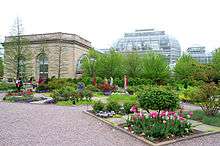
A discussion about moving the garden began in Congress in August, 1922. "It appears likely that the public features of the present garden will be transferred from the west side of the Capitol to the north side and that a new botanic garden and arboretum on an adequate scale will be established not far from the Capitol."[13]
The site of the original garden was fewer than 13 acres (53,000 m2), in comparison to the famous Royal Botanic Gardens at Kew in London, which had 288 acres (1.17 km2). The garden in Berlin, Germany, has over 1,325 acres (5.36 km2) and was established at a cost of over $4,000,000. In comparison, $1,416,748 was spent on the garden in Washington between the years 1842–1922. This included the original appropriation for the Wilkes expedition.[13]

Senate resolution 165 was passed and a committee was formed to review the acquisition of a new site. Lieut. Col. Clarence O. Sherrill, Corps of Engineers, secretary and executive officer of the fine arts commission, compiled a report on the garden.[13]
It was felt that the botanic garden must be removed because when Congress established the location of the Grant Memorial in the garden-area, technically, it forced the garden out. "Such was the intention of Congress."[13]
The action was entirely logical. That space was designed by President George Washington and Maj. Pierre Charles L'Enfant as an open approach to the Capitol, which is shown on the original plan to the city. "It was proposed at that time that this area should be subject to ornamentation with memorials, foundations, and the like, but not shut off by walls and fences. Locating the Botanic Garden in this area was one of those serious mistakes made in the early part of the century whereby the great plan for the Nation's Capital suffered damage that has continued to this day."[13]
Sherrill's report pointed out that the goal of Congress was to restore the Mall to its original status as a park connection between the legislative and executive departments. Congress had paid the Pennsylvania Railroad $1,500,000 to remove its tracks from the Mall. "The new National Museum Building, the Agriculture Department buildings, and the gallery for the Freer collections all have been located with reference in the general plan. Slowly, but steadily, changes in conformity with that plan are now being carried out throughout the entire 2½ miles from the Capitol Grounds to the Lincoln Memorial. The removal of the Botanic Garden is essential to the development of the great composition."[13]
"If Congress desires to continue a garden for the purpose of obtaining flowers for its members and for growing shrubs to disseminate throughout the country, both of these purposes can be subserved quite as well by glass houses and gardens in other accessible locations."[13]
It was also felt that the new location would provide enlargement of the Capitol Grounds on the north which affords an area for gardens of great beauty and distinction "through which will pass all visitors to Washington and a large proportion of those persons who daily go to the Capitol and Library of Congress."[13] The old location was seen as assessable to only "an insignificant fraction of visitors or residents" and that the removal of the garden from the west side of the Capitol to the north side made the features of the garden more available.[13]
An exhaustive search was made of several areas available for garden purposes and Mount Hamilton, a privately owned site, was chosen. The tract fronted the Anacostia River and carried a variety of soils in such condition that "very little preparation for the uses of a botanic garden would be needed and very little grading other than that required for roads."[13]
The tract had north, south, east and west slopes and a level area on Hickey Road that would work well for greenhouses and herbaceous gardens, while the other sloped areas would be ideal for shrub and small flowering-tree arboretum uses. The entire area contained about 400 acres (1.6 km2) and would "afford an entrance to Washington of unequaled beauty."[13]
In the future, it was felt that the garden could be expanded by "that portion of the park between the Pennsylvania Railroad and Benning Bridge contains about 563 acres, lowland and water, thus furnishing ample opportunity for expansion on land not subject to overflow for lowland and fresh-water exhibits."[13]

The Commission of Fine Art made recommendation that the Mount Hamilton tract be acquired for a national botanic garden and arboretum; by purchasing 400 acres (1.6 km2) of land, at least 800 acres (3.2 km2) of Government-owned lands will be made available. Also, a park entrance to the city from the north will be provided. Additionally, the public features of the "present" Botanic Garden be transferred from the west side of the Capitol to the north side to lands already owned by the Government.[13]
New location
In 1933, the main building was moved to its present location on the National Mall, just to the southwest of the Capitol, bordered by Maryland Avenue on the north, First Street on the east, Independence Avenue on the south, and Third Street on the west.[3] The facility includes a conservatory and 2 acres (8,100 m2) of outside grounds.[15] Directly across Independence Avenue is Bartholdi Park, an outdoor display area, and an administration building.[3][16] Located on 3 acres (12,000 m2) west of the conservatory and opened to the public on October 1, 2006, the National Garden provides living laboratories for environmental, horticultural, and botanical education.[17][18] The major features of the National Garden are the Rose Garden, the Butterfly Garden, the Lawn Terrace, the First Ladies' Water Garden, the Regional Garden, and an outdoor amphitheater.[17]
Plant production facility
A plant production facility in Anacostia, Washington, D.C., includes greenhouse bays and a support facility for the garden. The U.S. Botanic Garden Production Facility, covers 85,000 square feet (7,900 m2) under glass, and is the largest support facility for a botanic garden in the United States. It houses collections currently not on display, including plants recuperating. Seasonal plants are also grown at the facility for use in the Supreme Court, Library of Congress and for replenishing the Capitol grounds. An estimated 100,000 mums, pansies, cabbage, kale and other annuals and perennials per year are grown in the facility. Additionally, foliage plants for the Senate offices and palm trees for Capitol Hill events as well as special seasonal displays such as Easter lilies and poinsettias are all grown on site.[1] "According to staff botanists, there are about 50,000 plants on hand at the production facility at any one time.[1]
Current operation
Presently, the United States Botanic Garden is home to almost 10,000 living specimens, some of them over 165 years old.[5]
The national monument was closed for renovations on September 1, 1997, and reopened to the public on December 11, 2001. At the time of closure for renovation, plants in the collection were placed in storage at the USBG Production Facility, retired to greenhouses in Florida, or composted.
Facilities

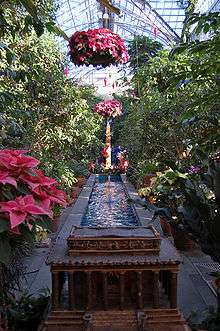
The USBG proper consists of three locations: the Conservatory, Bartholdi Park, and the Production Facility.
The historic Lord & Burnham greenhouse, built by the Architect of the Capitol in 1933, contains eight garden rooms under glass, totaling 28,944 square feet (2,689.0 m2) of growing space. In 2001, the Conservatory re-opened after a four-year renovation that required it to be completely dismantled and rebuilt using 21st century building standards.[14] The Conservatory is divided into separate rooms, each simulating a unique habitat:
- The Garden Court
- Rare and Endangered Plants (rare species, endangered species)
- Plant Exploration
- Orchid House (orchids)
- Medicinal Plants (medicinal plants)
- Desert (desert species)
- Hawaii
- Garden Primeval (primeval)
- Plant Adaptation
- Jungle (jungle species; this is the largest of the rooms, and includes a second-story catwalk so that the jungle canopy may be observed from both below and above)
- Children's Garden (courtyard; features many thriving temperate annuals used to encourage interest in plants)
- Southern Exposure (courtyard),on the south side of the building, is surrounded by glass walls, receiving more warmth. It features many plants from the Southeast and Southwest, which would not be able to live in the colder District of Columbia climate if not for the microclimate
Except for the Hawaiian house, the galleries, and south lobby, none of the conservatory has air conditioning. Each room is closely monitored by a computer-operated sensors to maintain the environment best suited to the plants in that room. Humidity, sunlight and temperature are regulated by means of a misting system, retractable shades and levered windows. All plants are watered daily by hand. Construction was completed on the 3-acre (12,000 m2) National Garden on the Botanic Garden's west border, in October 2006 and the garden includes a regional garden of plants native to the Atlantic Coastal Plain and Piedmont, a rose garden, a butterfly garden, and the First Ladies Water Garden, a water garden in memory of the First Ladies of the United States.The National Garden construction was funded by the National Fund for the U.S. Botanic Garden which now exists as a 'friends group'.
Bartholdi Park lies just south of the Conservatory, across Independence Avenue. It is named for the Bartholdi Fountain in the garden's center designed by Frédéric Bartholdi. One of the goals of this garden is to provide inspiration and ideas for home gardeners who visit it. It displays a variety of small structured and non-structured gardens, and infuses color, shape, and planting themes. One section of the garden is certified as a National Wildlife Federation Backyard Wildlife Habitat. The Park also houses the administrative building for the United States Botanic Garden.
The Production Facility in southwest D.C. is used for growing and storing plants for propagation, for collection maintenance, or for display in upcoming annual shows.
The USBG participates in CITES (the Convention on International Trade in Endangered Species), which means that it cares for plants seized by Customs. It specializes in orchids and succulents.
Wilkes plants
There are four plants in the garden that are believed to be directly related to the original Wilkes Expedition.

- The Vessel Fern (Angiopteris evecta) situated in the Jungle, is a fern believed to be the direct progeny of the Vessel Fern brought back on Wilkes' ship. Because of the lifespan of Vessel Ferns, it is highly unlikely that the present fern is the original; however it is believed that the present fern is a direct descendant and genetically identical to the original, called a clone or a cutting.
- The Ferocious Blue Cycad (Encephalartos horridus) is a cycad questionably one of the original Wilkes plants. Due to its size and possible age, some believe this plant to have come back with the expedition in 1842; unfortunately, early records are incomplete and inaccurate, so this is left to speculation.
- The Queen Sagos Cycas circinalis, which are cycads, live in the Garden Court. The Botanic Garden cares for both a male and a female of the species, and both were brought back with the Wilkes Expedition.
References
- 1 2 3 "US Botanic Garden - R & R for Plants". Garden Design Online, 2010. Retrieved 2010-06-20.
- ↑ Science - The Columbian Institute. New York, The Science Press, p.508, 1917. Retrieved 2010-06-08.
- 1 2 3 "Brief History of the U.S. Botanic Garden". United States Botanic Garden. Washington, DC: United States Botanic Garden. Retrieved 2010-07-08. External link in
|work=(help) - 1 2 "Greene: American Science in the Age of Jefferson.". Ames: Iowa State University Press, 1984. Retrieved 2010-06-10.
- 1 2 3 4 5 Welches, Sandy. "Our Nation's Greenhouse: The Mall, Washington, D.C." (PDF). Trumpet Vine, 2008. Retrieved 2010-06-07.
- 1 2 3 Haskin, Frederic J. (April 3, 1940). "Q and A, University of the Masses.". The Arizona Republic. Phoenix, Arizona.
- 1 2 3 Journal of the Washington Academy of Sciences, Volume 8. Washington Academy of Sciences - The Waverly Press, p.491, 1918. Retrieved 2010-06-20.
- ↑ Brief History of the U.S. Botanic Garden. United States Botanic Garden Conservatory. Retrieved 2015-10-30.
- 1 2 3 4 5 6 Haskin, Frederic J. (January 1, 1932). "The Haskin Letter (Washington, D.C.) - The New Botanic Gardens.". Billings Gazette. Billings, Montana.
- 1 2 3 4 5 6 7 Fallen, Anne-Catherine. "The United States Botanic Garden, Establishing a Plant Collection" (PDF). U.S. Government Printing Office, 2007. Retrieved 2010-06-18.
- ↑ "Congressional.". The Torch Light And Public Advertiser. Hagers-Town, Maryland. December 25, 1828.
- 1 2 "Famous Botanic Garden.". Oxford Leader. Oxford, Iowa. March 31, 1932.
- 1 2 3 4 5 6 7 8 9 10 11 12 13 14 15 16 Sherman, John Dickinson (August 10, 1922). "Botanic Garden Must Be Moved - Congress Discusses Its New Site.". Haskell News. Haskell, Oklahoma.
- 1 2 "Capitol Campus: U.S. Botanic Garden". The Architect of the Capitol, Washington, D.C. Retrieved 2010-06-20. External link in
|publisher=(help) - ↑ "Conservatory". United States Botanic Garden. Washington, D.C.: United States Botanic Garden. Retrieved 10-07-08. Check date values in:
|access-date=(help); External link in|work=(help) - ↑ "Bartholdi Park". United States Botanic Garden. Washington, D.C.: United States Botanic Garden. Retrieved 10-07-08. Check date values in:
|access-date=(help); External link in|work=(help) - 1 2 "National Garden". United States Botanic Garden. Washington, D.C.: United States Botanic Garden. Retrieved 10-07-08. Check date values in:
|access-date=(help); External link in|work=(help) - ↑ "US Botanical Garden". Flickr. Yahoo, Inc. 2010. Retrieved 2010-06-20. External link in
|work=(help)
External links
| Wikimedia Commons has media related to United States Botanic Garden. |
-
 Geographic data related to United States Botanic Garden at OpenStreetMap
Geographic data related to United States Botanic Garden at OpenStreetMap - "United States Botanic Garden". Official website of the United States Botanic Garden, Washington, DC. Retrieved 2010-07-08.
- "A Botanic Garden for the Nation: the United States Botanic Garden". United States Botanic Garden, Washington, DC. Retrieved 2010-07-08. Website contains a link to download a free electronic version of an illustrated 180 page book about the U.S. Botanic Garden (Botanic Garden for the Nation: the United States Botanic Garden. Publisher: Congress, Architect of the Capitol, United States Botanic Garden, 2007.)
- U.S. Botanic Garden in Washington, Tanglewood Conservatory
